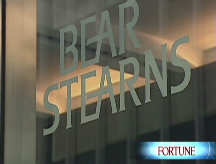Crime and delusion on Wall Street
Prosecutors allege two ex-Bear Stearns hedge fund managers misled investors. Perhaps, but Wall Street has long been kidding itself about the credit crunch.
 |
| Former Bear Stearns hedge fund managers Ralph Cioffi (right) and Matthew Tannin surrendered Thursday to the FBI. |
NEW YORK (Fortune) -- Coming soon to a docket near you: The first criminal case of the credit crunch.
Two former Bear Stearns hedge fund managers, Ralph Cioffi and Matthew Tannin, were indicted Thursday by a federal grand jury on charges they intentionally misled investors in two funds that collapsed last summer under the weight of wrong-way bets on mortgage-backed securities. Cioffi and Tannin, who surrendered Thursday morning to the FBI, face charges of conspiracy, securities fraud and wire fraud. Cioffi faces an additional charge of insider trading.
The case turns on the question of what the men knew when they told investors they were hopeful about the funds' prospects - at a time when their performance was deteriorating and some investors were trying to withdraw money.
"The indictment alleges that by March 2007, the defendants believed that the funds were in grave condition and at risk of collapse," Benton Campbell, U.S. attorney for the Eastern District of New York, said in a statement. "However, rather than alerting the funds' investors and creditors ... the defendants made misrepresentations to stave off withdrawal of investor funds and increased margin calls from creditors in the ultimately futile hope that the funds' prospects would improve and that the defendants' incomes and reputations would remain intact."
In an echo of prosecutions following the collapse of the technology stock boom, the government's case relies in part on e-mails that allegedly show the managers had private doubts even as they were publicly expressing confidence.
In an April 2007 message to Cioffi, for instance, Tannin wrote that the market for subprime-related securities - bonds the funds had made big leveraged bets on - "looks pretty damn ugly. ... If we believe [our internal modeling] is ANYWHERE CLOSE to accurate I think we should close the funds now."
Tannin went on to write that if the firm's modeling was accurate, "then the entire subprime market is toast." If highly-rated securities were downgraded, he added, "there is simply no way for us to make money - ever."
Yet at the same time, prosecutors allege, "the defendants led investors and creditors to believe that, despite the challenges presented in the market, the funds would continue to generate an increasing net asset value."
Lawyers for Cioffi and Tannin said in a joint statement Thursday that the subprime mess "took everyone by surprise, including the Fed and Treasury," and led to more than $300 billion of losses at financial firms.
"Because his funds were the first to lose might make him an easy target but doesn't mean he did anything wrong," said Cioffi lawyer Ed Little. "Indeed, Mr. Cioffi had no motive to do anything wrong. He did not and could not have profited by doing anything the government now claims he did." Susan Brune, attorney for Tannin, said her client "is being made a scapegoat for a widespread market crisis. He looks forward to his acquittal."
The case against Cioffi and Tannin will take a while to play out. But what's clear today - and appears to be central to the managers' defense - is that the Bear Stearns managers were far from alone in failing to warn investors of the sea change in the credit markets. Indeed, top guns on Wall Street have spent a lot of time deceiving themselves about the depth of the mortgage mess.
The prosecution comes almost exactly a year after reports of problems at the funds, called the High-Grade Structured Credit Strategies and High-Grade Structured Credit Strategies Enhanced Leverage funds, bubbled to the surface. The funds' subsequent descent into bankruptcy exposed the first cracks in the teetering edifice that was Bear Stearns, then the nation's No. 5 brokerage firm. Bear narrowly survived a confidence crisis in August before collapsing this spring into the arms of JPMorgan Chase (JPM, Fortune 500). Prosecutors made clear Thursday that they believe Cioffi and Tannin misled investors in their funds, but that they don't hold the men responsible for the collapse of corporate parent Bear Stearns.
The more aggressive of the two Bear Stearns funds, the so-called Enhanced fund, was launched in 2006 to take advantage of the peak of the credit boom, in part by betting - using large amounts of borrowed money - on the decline of indexes representing the value of subprime-related securities. But both the Enhanced fund and the original High Grade fund - which had been launched in 2003 and had, until early 2007, been profitable every month since - began running into trouble as the value of subprime securities plunged.
That turn, together with the funds' heavy leverage, meant losses mounted quickly. Merrill Lynch, alarmed by the losses and unimpressed by Bear Stearns' plan to restructure the funds, then stepped in and seized some bonds the funds had put up as collateral - further unnerving investors.
Reports of troubles at the High Grade funds didn't appear in the business press until last June. But by then, Bear was already indulging in the self-defeating damage-control cycle that since has been evident at almost every turn in the credit crisis.
In April, for instance, Cioffi reassured hedge fund investors on a conference call that he was "very comfortable" with the funds' financial position. The comments came a month after Cioffi had moved $2 million of his own money out of one of the troubled funds into a third Bear Stearns hedge fund, and even as Tannin and Cioffi expressed doubt about the funds' ability to weather the subprime storm. Tannin, for his part, was assuring investors that he was boosting his investment in the funds - an assurance that proved false, prosecutors said. Cioffi's decision to move the money, without informing investors of his decision to do so, led to the charge of insider trading against Cioffi, prosecutors said.
As it turned out, Cioffi had little to be optimistic about. The Enhanced fund eventually found it had lost 19% of its value in April alone - despite, according to prosecutors, the efforts of Cioffi to force Bear Stearns Asset Management's pricing committee that the loss was just 6%. When asked to document his claim for the committee, Cioffi "was unable to produce any evidence supporting his alternative pricing method," prosecutors allege.
Cioffi and Tannin also sought to mislead investors about whether the funds were facing the requests for withdrawals known as redemption requests, prosecutors said. On May 3, for instance, prosecutors say Tannin told a lender to the funds that they didn't expect large redemption requests. In fact, the government says, by that time 13 investors - including the fund's biggest investor, who wasn't identified, and Cioffi himself had sought redemptions.
Prosecutors say Tannin and Cioffi misled their superiors at Bear Stearns Asset Management about the funds' parlous state. That said, Bear itself didn't cover itself in glory with its handling of the problems at the funds.
Under pressure from lenders threatening to seize the funds' collateral, Bear in late June issued a public statement blandly promising to "stabilize the situation," then promised to lend as much as $3.2 billion to keep the funds from collapsing. But in July, as the funds were preparing for a bankruptcy filing, the firm admitted that investors in the funds would recoup less than a dime on every dollar they invested. As it turns out, they recouped nothing.
The bad news at Bear should have warned others on Wall Street to dig into their exposure to risky mortgage-related bets. Yet even as the collapse of the High Grade funds was being dissected in the press, other big subprime-writedown losers such as UBS (UBS), Merrill Lynch (MER, Fortune 500) and Citigroup (C, Fortune 500) remained in denial - initially underestimating eventual losses and eroding investor confidence by citing supposedly unforeseeable market conditions. Top execs were forced out at all three firms.
Even now, a year after the High-Grade funds started to wobble and months after the house cleanings that cost Chuck Prince and Stan O'Neal their jobs, those simple lessons are still being learned.
At AIG (AIG, Fortune 500), CEO Martin Sullivan was forced out after he oversaw two record quarterly losses just months after blithely reassuring investors the insurer's subprime exposure was limited. At Lehman Brothers (LEH, Fortune 500), two top execs were demoted last week after the firm insisted it wouldn't need to raise more capital to offset future losses, only to later do so twice.
In both instances, the firms claimed they had a handle on their mortgage-related problems, only to admit otherwise later - at great cost to shareholders.
Now Cioffi and Tannin will serve as the criminal test case. And however it ends, the events of the past year have shown that people who should have known better were all too willing to be misled. ![]()
-
 The retail giant tops the Fortune 500 for the second year in a row. Who else made the list? More
The retail giant tops the Fortune 500 for the second year in a row. Who else made the list? More -
 This group of companies is all about social networking to connect with their customers. More
This group of companies is all about social networking to connect with their customers. More -
 The fight over the cholesterol medication is keeping a generic version from hitting the market. More
The fight over the cholesterol medication is keeping a generic version from hitting the market. More -
 Bin Laden may be dead, but the terrorist group he led doesn't need his money. More
Bin Laden may be dead, but the terrorist group he led doesn't need his money. More -
 U.S. real estate might be a mess, but in other parts of the world, home prices are jumping. More
U.S. real estate might be a mess, but in other parts of the world, home prices are jumping. More -
 Libya's output is a fraction of global production, but it's crucial to the nation's economy. More
Libya's output is a fraction of global production, but it's crucial to the nation's economy. More -
 Once rates start to rise, things could get ugly fast for our neighbors to the north. More
Once rates start to rise, things could get ugly fast for our neighbors to the north. More









